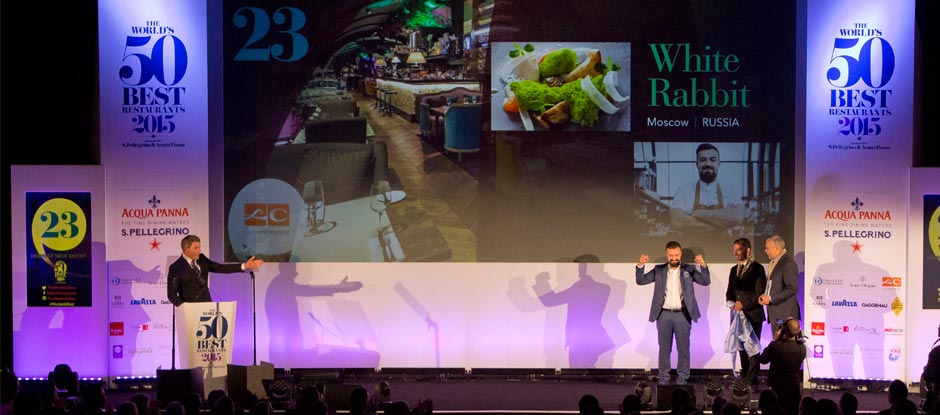Wow! Moscow-based White Rabbit just made a tremendous climb in The World’s 50 Best Restaurants, making its debut to the list at No.23. If you plan on visiting the Russian capital, you should catch up on what’s been happening on the restaurant scene.
At the beginning of 2014, Moscow’s restaurant market was still embracing western values by the book, with venues growing like mushrooms after a warm shower and gastronomic life flourishing with food festivals and mini-markets. But now changes seem imminent.
The breaking news of the government banning imported foods took the ‘new middle class’ by surprise. Television and social media exploded with questions ranging from the selfish “How can I survive without Camembert?” to the scary “What’s next? Wine? Cars? Being able to travel abroad?” The final question was: “How will restaurants handle it?”
Despite the food import ban, which was damaging at first sight, most Russian chefs and restaurant owners managed to overcome the problem and find local suppliers, in many cases changing recipes and restaurant concepts. “We totally switched to local meat including chicken, turkey, goat meat and lamb,” said Ivan Shishkin, the chef at the Delicatessen in the center of Moscow.
Moscow, which has around 3,000 to 4,000 restaurants, bars and cafes, is dominated by big groups rather than big chefs. Novikov Group, Ginza Project, Restaurant Syndicate and Maison Dellos have already grown beyond the two Russian capitals, Moscow and St. Petersburg, and some have launched restaurants in London and New York. Their business schemes include posh design, trendy musicians and a couple of celebs, and they’re set in the right locations and shaken up with a powerful PR blender.
The truly unique skill of Moscow restaurateurs has always been problem-solving. The fact is that any Moscow restaurant can be instantly closed down simply because the outdated restaurant regulations are extremely hard to comply with. It is the restaurateur’s role to manage everything from landlords and health inspections to specific recipes.
Moscow chefs, too, have developed skills uncommon among their western peers, and they have to think outside the box in order to make it. Anton Kovalkov, born in the city of Nizhny Novgorod, just 250 miles away from Moscow, was the first Russian to get training at Noma. Ivan and Sergey Berezutsky, Vladimir Mukhin, Ivan Shishkin, Dmitry Zotov, Anatoly Kazakov, Dmitry Shurshakov are notorious examples — the list not being exhaustive. “Chefs are now both capable and willing to do great things,” says Andrey Fedorin, who manages MariVanna, Ugolyok and Uilliam’s. “They are more involved in business than ever before.”
Restaurant owners are changing, too. Once obscure investors who told chefs what to do, they have now become clever foodies, giving interviews and hanging out in open kitchens in front of their guests. White Rabbit, Zodiac and Selfie founder and managing director Boris Zarkov is widely considered a new type of restaurant CEO, forming close partnerships and friendships with creative and modern chefs like Vladimir Mukhin of White Rabbit.
Famous chef Anatoly Komm has been struggling to prove Russians are ready to enjoy complex gastronomy — including molecular cuisine — on a regular basis, seemingly dreaming of himself as a Don Quixote of the Russian culinary landscape. While Mr. Komm is certainly seen as an influential chef, his ideas of introducing Moscow’s population to experimental fine dining are generating mixed responses from both professionals and visitors, with mockery and worship forming intricate patterns.
It seems that what Muscovites are expecting these days is a more down-to-earth approach, and that’s what the major groups are coming up with — just take a bite of the burgers at the new Novikov place, #Farsh, (literally meaning “ground beef”), for an example. We’ll have to watch this space to see how it plays out.

